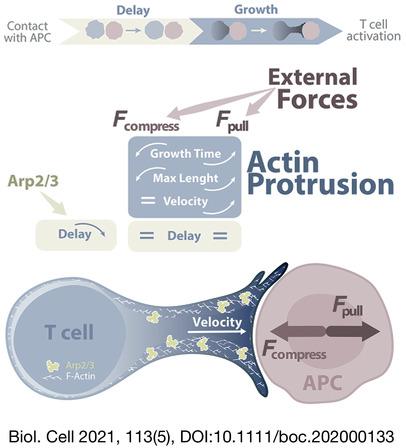Influence of external forces on actin-dependent T cell protrusions during immune synapse formation
Abstract
Background Information
We have previously observed that in response to antigenic activation, T cells produce actin-rich protrusions that generate forces involved in T cell activation. These forces are influenced by the mechanical properties of antigen-presenting cells (APCs). However, how external forces, which can be produced by APCs, influence the dynamic of the actin protrusion remains unknown. In this study, we quantitatively characterised the effects of external forces in the dynamic of the protrusion grown by activated T cells.
Results
Using a micropipette force probe, we applied controlled compressive or pulling forces on primary T lymphocytes activated by an antibody-covered microbead, and measured the effects of these forces on the protrusion generated by T lymphocytes. We found that the application of compressive forces slightly decreased the length, the time at which the protrusion stops growing and retracts and the velocity of the protrusion formation, whereas pulling forces strongly increased these parameters. In both cases, the applied forces did not alter the time required for the T cells to start growing the protrusion (delay). Exploring the molecular events controlling the dynamic of the protrusion, we showed that inhibition of the Arp2/3 complex impaired the dynamic of the protrusion by reducing both its maximum length and its growth speed and increasing the delay to start growing. Finally, T cells developed similar protrusions in more physiological conditions, that is, when activated by an APC instead of an activating microbead.
Conclusions
Our results suggest that the formation of the force-generating protrusion by T cells is set by an intracellular constant time and that its dynamic is sensitive to external forces. They also show that actin assembly mediated by actin-related protein Arp2/3 complex is involved in the formation and dynamic of the protrusion.
Significance
Actin-rich protrusions developed by T cells are sensory organelles that serve as actuators of immune surveillance. Our study shows that forces experienced by this organelle modify their dynamic suggesting that they might modify immune responses. Moreover, the quantitative aspects of our analysis should help to get insight into the molecular mechanisms involved in the formation of the protrusion.


 求助内容:
求助内容: 应助结果提醒方式:
应助结果提醒方式:


